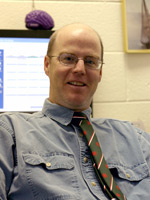Griffin delivers distinguished faculty lecture on thermoregulation
 Neuroscience is the fastest-growing
undergraduate discipline at William and Mary, as well as being the
oldest, according to John Griffin, associate professor of biology and
coordinator of the College’s interdisciplinary program in neuroscience.
Neuroscience is the fastest-growing
undergraduate discipline at William and Mary, as well as being the
oldest, according to John Griffin, associate professor of biology and
coordinator of the College’s interdisciplinary program in neuroscience.
Griffin presented “Thermoregulation—Fever and Hot Flashes … Oh My!” recently at the Seventh Annual Dean’s Distinguished Faculty Lecture. He sketched the history of brain science, delivered a primer on the neuroscience of body-temperature regulation and gave the neurological basis for several common body-temperature-related phenomena to an audience of about 100 faculty, students and members of the community. Griffin also presented glimpses of his own neuroscience research while citing by name a number of undergraduate students who have contributed to the work in his lab.
Carl Strikwerda, dean of the faculty of arts and sciences, introduced Griffin, noting that neuroscience is a true interdisciplinary pursuit because it is “the intersection of psychology, biology and physiology.” The undergraduate program at the College is particularly successful, Strikwerda said, with 17 faculty members from diverse departments and 130 students.
“Our faculty have been taking undergraduate students to conferences to read papers in neuroscience,” Strikwerda said. “Faculty from other universities have heard these papers and talked to our students, asking them what graduate school they were enrolled in. When our students said ‘Well, I’m a senior,’ the faculty started trying to recruit them for their graduate programs.”
The neuroscience program’s connection to William and Mary is older than the College itself, Griffin said. This singular connection leads through the College’s Wren Building to its namesake, the British architect and polymath Sir Christopher Wren. Griffin displayed a reproduction of a Christopher Wren drawing published in 1664 illustrating the Circle of Willis, the vascular structure of the brain described by Sir Thomas Willis.
Griffin outlined the history of neuroscience from a 4000 B.C. Sumerian reference to the euphoric properties of the poppy plant through Hippocrates’ controversial assertion circa 400 B.C. that the brain is the seat of intelligence and on up to the contributions and discoveries of a host of Nobel laureate neuroscientists beginning in 1906.
“I tell my students, ‘If you want to win a Nobel Prize, go into neuroscience,’” he said. The history of neuroscience is not without sidetracks into error, though. Griffin mentioned the book Elements of Phrenology, which was published in 1824 and proposed that brain function could be diagnosed by reading bumps on the skull. There also are curiosities. Griffin displayed an ancient cuneiform script for the word “fever” that is eerily similar to modern illustrations of neural networks.
Griffin’s own research in thermoregulation was based on that of his
mentor, Harold T. Hammel, a Manhattan Project physicist who transferred
his talent and attention to physiology. Hammel developed a neurological
model of body-temperature regulation. The goal of thermoregulation,
Griffin explained, is to maintain an ideal operating temperature of
around 38 degrees Celsius, a body’s “set point.”
“But body
temperature is a bit of a misnomer,” he said, “because body temperature
depends on where you’re looking at.” A neurally regulated system of
vasoconstrictors and vasodilators regulates blood flow to favor keeping
the body core and the brain warm at the expense of the extremities, he
noted.
“If it’s really cold, we can restrict blood flow so much that we keep blood flow going in the thorax and let the big toe fall off,” he said. “That’s what happens in frostbite.”
The central nervous system’s seat of temperature regulation, he
explained, is the hypothalamus. Hammel’s model of regulation is based
on the firing of discrete sets of neurons in the hypothalamus. Using a
Power Point demonstration to illustrate, Griffin explained how
warmth-sensitive neurons and temperature-insensitive neurons react to
external and internal changes to maintain body temperature.
“What
actually happens during a fever?” Griffin asked. “Well, when we think
about it, the set point changes. You climb under the covers, put a heat
pack on your head and shiver. You’re trying to bring your body
temperature up to your new set point.”
Griffin characterized hot flashes as “mini-fevers.” Scientists have begun taking a more serious look at hot flashes, he said, because they now recognize a true physiological response in what for years had been dismissed as a side effect.
 Skip to main content
Skip to main content
